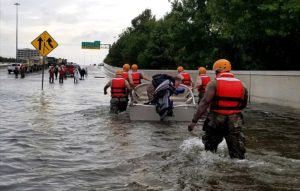
Now that the floodwaters are receding in Houston and the rest of South Texas, many journalists are focusing on new dangers faced by survivors. One of the hardest to quantify is toxic pollution from oil refineries and chemical plants.
Reporting on risk is always tricky. How do you help your audience understand the dangers they might face without causing undue fear? We asked that question of experts some 15 years ago in connection with reporting on terrorism. Their answers are equally useful today in the aftermath of a natural disaster.
Recognize the emotions. Scientists who study risk say it’s important to understand how people perceive risk. “We are more afraid of risks that kill us in really awful ways than risks that lead to deaths that are more peaceful,” says David Ropeik of the Harvard Center for Risk Analysis in a column on MSNBC.com. “We are also more afraid of risks that kill a lot of us, all at once in one place, than risks that kill us here and there, over time.” Journalists need to address the psychology of risk in their reporting. How?
- Describe what people can do to reduce their risk of exposure.
- Review measures that experts do not recommend for most people, and tell why.
- Explain what government and medical authorities are doing to reduce the risk.
- Report on the frequent disconnect between facts and fears to give people perspective.
Examine the risk. People need information that will help them assess they risk they could face in their daily lives. Provide the facts that will help them put risk in context.
- Tell what you can about the likelihood of exposure in your community.
- Describe how many people this affects, out of how large a population, and how they are affected.
- Be clear about where a substance has been found, and how much was found.
Compare risks. Comparing risks can help viewers decide just how threatening a situation is for them. But be careful. Martha Walter, Michael Kamrin and Delores Katz, who wrote a handbook for journalists on risk reporting, say some comparisons are more useful than others. “The most useful risk comparisons compare similar risks, compare risks with alternatives, or compare risks with benefits,” they write.
- Compare the risk of death from one agent to the risk of different agents, not to other diseases.
- Don’t compare involuntary risk (risk of toxic exposure) to voluntary, avoidable risk (risk of smoking).
Consider what is unknown. Avoid the appearance of certainty where none exists. As Science News correspondent Ivars Peterson told the science journalism center at the University of Missouri, “Readers may be better served by hearing more of the process and uncertainty of science and math.”
- Clarify whether you are reporting exact numbers or estimates, and the confidence level of those estimates.
- Tell what you don’t or can’t know as well as what you do.








